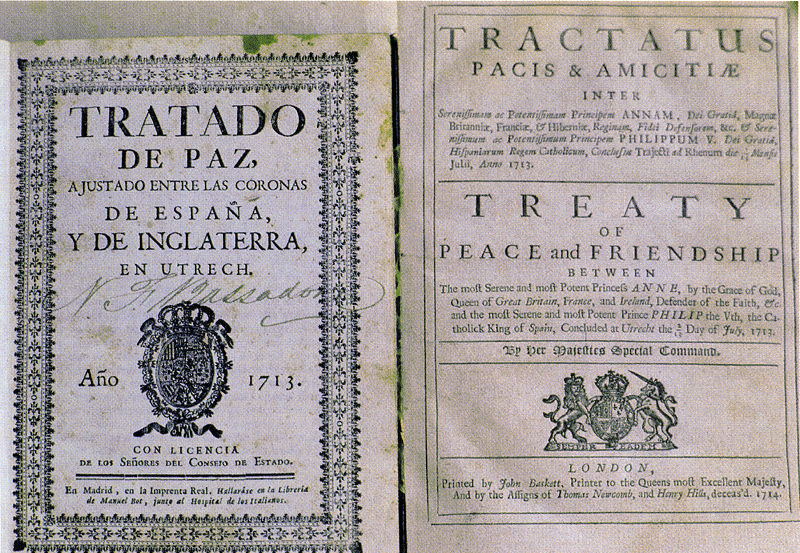Treaty of Utrecht (1713-1715)
Enlarge text Shrink text- Fäsi, J.K. Abhandlungen über die Geschichte des Friedensschlusses zu Utrecht ... 1790.
- The culture of contention, c1997:p. 11 (Peace of Utrecht)
- Wikipedia, Nov. 30, 2007(The Treaty of Utrecht that established the Peace of Utrecht, rather than a single document, comprised a series of individual peace treaties signed in the Dutch city of Utrecht in March and April 1713; the treaties were concluded between the representatives of Louis XIV of France and Philip V of Spain on the one hand, and representatives of Queen Anne of Great Britain, the Duke of Savoy, and the United Provinces on the other; other language articles give title as: Friede von Utrecht; Tractat d'Utrecht; Traités d'Utrecht; Tratado de Utrecht; Traktato de Utrecht; Trattato di Utrecht; Yutorehito jōyaku; Utrechto sutartis; Perjanjian Utrecht; Vrede van Utrecht (1713); Pokój utrechcki 1713; Utrechtský mier; Freden i Utrecht; Sporazum u Utrehtu)
- Encyc. Britannica online, May 19, 2008(treaties of Utrecht, also called Peace of Utrecht (Apr. 1713-Sept. 1714), a series of treaties between France and other European powers (Apr. 11, 1713 to Sept. 7, 1714) and another series between Spain and other powers (July 13, 1713 to June 26, 1714), concluding the War of the Spanish Succession (1701-14))
- The Treaties of Utrecht, signed in 1713, put an end to the War of Spanish Succession (1701-13); treaties of 1713-14 ( (The Treaties of Utrecht (1713), via WWW, May 19, 2008) )
- Infoplease.com site, May 19, 2008(Utrecht, Peace of; series of treaties that concluded the War of the Spanish Succession; between 1713-1715)
- Catalogue Bn-Opale plus, via WWW, May 19, 2008(Traités d'Utrecht (1713-1715); besides the treaty signed at Utrecht on 11 Apr. 1713 are the treaties of Rastatt (6 Mar. 1714), Baden (7 Sept. 1714), and Anvers (15 Nov. 1715), which are grouped together under the name Traités d'Utrecht)
The Peace of Utrecht was a series of peace treaties signed by the belligerents in the War of the Spanish Succession, in the Dutch city of Utrecht between April 1713 and February 1715. The war involved three contenders for the vacant throne of Spain, and involved much of Europe for over a decade. Essentially, the treaties allowed Philip V (grandson of King Louis XIV of France) to keep the Spanish throne in return for permanently renouncing his claim to the French throne, along with other necessary guarantees that would ensure that France and Spain should not merge, thus preserving the balance of power in Europe. The treaties between several European states, including Spain, Great Britain, France, Portugal, Savoy and the Dutch Republic, helped end the war. The treaties were concluded between the representatives of Louis XIV of France and of his grandson Philip on one hand, and representatives of Queen Anne of Great Britain, King Victor Amadeus II of Sardinia, King John V of Portugal and the United Provinces of the Netherlands on the other. Though the king of France ensured the Spanish crown for his dynasty, the treaties marked the end of French ambitions of hegemony in Europe expressed in the continuous wars of Louis XIV, and paved the way to the European system based on the balance of power.
Read more on Wikipedia >
 Title
Title


.jpg)




